|
St Francis |
|

ELECTRONICS
Last Updated: 04/28/2023
Future Additions:
12-19 Volt Step Up Transformer
Handheld Depth Sounder
Soggy Paws has 3 laptop computers aboard, all wifi equipped. However, early on we discovered that the wifi cards built into most laptops are pretty lame. Since email and the internet are a big part of our travel experience, having a better wifi setup seemed to be worth investing some time and money in. There are now several marine-oriented commercial offerings, and Practical Sailor has done several articles testing various configurations.
The ideal setup for the techie, is not necessarily the ideal setup for the average not-too-techie on a boat. If you ask a techie, they will tell you need an antenna at the top of the mast, connected to 'router, a device that will make a little wifi hotspot on your boat. This IS a nice setup because it lets you share a shore-based internet connection with everyone onboard. However, it does take some technical knowledge to install, setup, and use. They cost in the $200-$300 range, maybe even more once you get it installed. They also usually need an external power source (12v or 110v).
The solution we recommend to our friends is a pretty simple setup, is powered off the USB port on your computer, and gives you 95% functionality at half or one third the cost. This also ends up being very portable, so we also take it with us 'on travel'.
Here is a link on Amazon.com for what we would buy today for an easy to use external wifi adapter:
Alfa AWUS036H 1000mW 1W 802.11b/g USB Wifi - $25.00
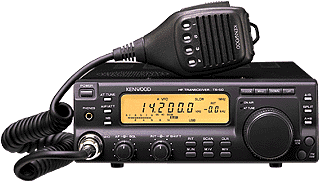 Our
Inexpensive HF Radio Solution
Our
Inexpensive HF Radio Solution
We get lots of questions about what kind of SSB we have on Soggy Paws. We get reports all the time about our "great signal", and people ask how many watts we're running.
Well, it's really not about the radio, but more about our installation.
Our radio is a tiny, inexpensive Kenwood TS-50. It was designed as a "mobile" (car) radio. It is about the size of a VHF, and only runs 100 watts of power. You can still find them used in the $300-$500 range. We bought two for less than the price of a new Icom SSB. A similarly priced popular alternative is the Icom-706 MKIIG.
Our antenna is a typical yacht "backstay" antenna, coupled with an SGC-230 antenna coupler. But the magic is in our ground system. Dave read all the advice, and then followed it meticulously. (The advice we followed is Gordon Wests' Seawater Ground System). You don't need miles of copper foil (that's the old way and doesn't work well with today's auto tuners. Here are the components of our system.
1. TS-50 radio at Nav Station, mounted so no water can get to it. (An alternative to the TS-50 is the Icom 706 Mark II G)
2. SGC 230 tuner/coupler located below decks as close to the antenna as possible. Connect the antenna to the stud on the tuner. Though the SGC tuner is designed to be waterproof, it isn't always completely so, and so is better located out of the weather.
3. RG58 coax between radio and tuner, with a T4 Line Isolator inline. The Line Isolator helps strip off interference coming back to the radio receiver from downstream.
4. 16 gauge control wires between radio and tuner
5. 3-inch copper foil from tuner to dynaplate(s) (fastened to hull on outside of boat) and rudder post bolt
6. Tinned GTO 15 wire for your transmission wire from your tuner/coupler to your antenna. It should be less than 10' long and stood off from any other metal 2-4 inches along its entire run. At the antenna connection, loop the end up and then back down before making the connection to keep rain from getting inside the wire. Connect to the antenna using any device that will strongly clamp the bare GTO 15 to the antenna wire. Seal the connection and check it yearly for corrosion. (Source: West Marine)
7. HF ferrites on all radio, and Pactor wires.
8. Ground wire from tuner to radio with capacitors, see Stan Honey's article
Read Stan Honey's article on Grounding and make sure all your grounds comply. But use Gordon West's advice for using a seawater ground for the HF ground. Both articles can be found here.
There are several options for an HF antenna aboard a sailboat.
-
Insulated/split backstay with two insulators--about $400 depending on wire size plus labor if needed. If you are using an isolated backstay for your antenna is needs to be at least 35' long and have insulators both top and bottom. The top insulator should be at least two feet down from the top of the mast in order to provide good separation
-
Separate long wire antenna from mast head to stern rail at aft corner of deck-- about $50 for line and ss wire, install yourself.
-
Whip antenna mounted on the stern deck--probably several hundred dollars but depends on model chosen, install yourself.
We helped a friend rig a 30-foot long wire antenna, using small stainless steel rigging wire, with small loops swaged in the ends. The top end tied to the mast and the bottom end tied to the stern quarter out of the swing of the boom, using high strength small diameter rope. Of course the bottom end needs to also be connected to the tuner.
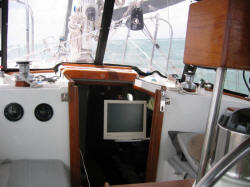 Though
we currently have an inexpensive ($500 USD) Garmin chart plotter/fishfinder
at our helm, we do most of our serious navigation with a laptop running
OpenCPN
Though
we currently have an inexpensive ($500 USD) Garmin chart plotter/fishfinder
at our helm, we do most of our serious navigation with a laptop running
OpenCPN
On our last boat, we left the laptop down below and used an external monitor that we could swing out into the companionway. (see pic below).
We used an inexpensive (less than $150) 15" 12 volt LCD monitor (not waterproof,
but we made a cover for messy wx) mounted on a small West Marine swing-out arm
in the companionway.
 We
specifically chose an LCD monitor with a 12v-type plug and a brick adaptor.
We cut off the cord at the LCD's 'brick' power adaptor and spliced it into a 12 volt wire
coming directly from the 'GPS' 12 volt circuit breaker panel.
We
specifically chose an LCD monitor with a 12v-type plug and a brick adaptor.
We cut off the cord at the LCD's 'brick' power adaptor and spliced it into a 12 volt wire
coming directly from the 'GPS' 12 volt circuit breaker panel.
We purchased a 12-volt adaptor for the laptop, too. So
everything runs directly off 12v.
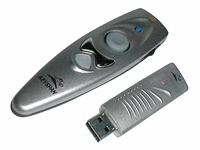
The device that really made this setup convenient was a 'presentation mouse' that provides mouse
capabilities from as far as 15' from the computer, wirelessly. This
allowed us to control the computer from the cockpit without having to go
below. Now the computer is safe and secure on the navigation table
down below while we are watching the LCD screen and controlling the computer
while on watch in the cockpit. This minimizes the computer's exposure
to the elements. I experimented with a few inferior brands before I
found the
Keyspan Wireless Presentation Mouse (about $40 on Amazon.com)
Note that on our new boat, as of 2020, we are using an Android tablet as our "remote monitor". See below.
We often operate with 2-3 different navigation programs running at the same time, as each does a different function better. To facilitate this, we use a piece of commercial software called GPSGate. GPSGate takes the NMEA input from one physical serial port and creates 1 to 4 pseudo-serial ports with the same information. (We use a Globalsat USB GPS for the GPS signal)
Here are the most common programs that we use:
- OpenCPN - A fully-featured Open Source (free) navigation program for Windows, Linus, and Apple. We used to use Maxsea, but now rarely use Maxsea in favor of the much-less-quirky OpenCPN. This program can use/read many different formats of electronic charts, including the ubiquitous CM93/v2 charts, KAP file charts, and Google Earth charts.
- Sat2Chart - A program that allows us (in port) to make satellite charts from Google Earth and other satellite imagery sources.
- WXTide32 (free world tides)
- Airmail (email and position reporting via HF/SSB or Iridium/iSatPhone)
See More Computer Navigation Topics in our New Computer Section
Wireless "Remote" Touch Screen for Laptop
I was just about to buy an expensive remote screen with touchscreen capabilities, when a friend introduced me to a better alternative. Nowadays, everyone has some kind of tablet on their boat. With the addition of a cheap local "router" and a free software program, we have turned our Android tablet into a wireless remote touchscreen for our laptop.
The software solution is called Teamviewer. You install Teamviewer on the laptop and on the tablet (both iPad and Android versions available), and Teamviewer will shadow whatever is on the computer screen wirelessly onto the table. You need internet to set up Teamviewer initially, but once set up, Teamviewer will run completely on the internal network. We have used ours on a normal desktop router, as well as a USB-powered cell data "mifi" device.
During our winter interlude in Hawaii in 2010/2011, and anticipating a lot of open-ocean sailing, we broke down and bought a Class-B AIS transponder. After much agonizing, the unit we bought was the Vesper Marine AIS Watchmate 850, which retails for around $1000 ($1500 with accessories). The other unit we carefully considered was the AMEC 'black box' unit sold by Milltech Marine for $500 (accessories included). Huge price difference! But we opted for the Vesper with the display because the display will allow us to monitor and see our targets WITHOUT having our computer running. And the Vesper unit was designed by a sailor for sailors (lower power consumption than most powerboat oriented units). So far we have not been disappointed in the choice.
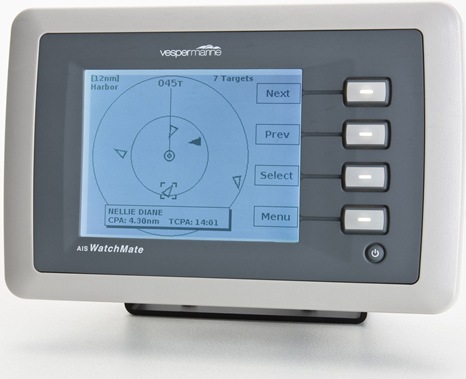
With our normal VHF antenna at the top of the mast, using Vesper's VHF/AIS splitter, we can 'see' ships with Class A AIS up to about 25 miles, and yachts with a Class B transmitter about 5-7 miles away. Having immediate notification that there's a ship in your area is just invaluable, and knowing that he can 'see' you too is even better.
After a heated discussion about cutting another hole in the bulkhead (I wanted the Watchmate mounted in the cockpit), we decided to mount it down below at the nav station. We flush mounted it rather than use the supplied bracket, which is designed for console mount. The flush mount made the internal patch antenna unusable, but we had, as a precaution, bought the external antenna with the unit too. Again after a discussion about where to mount it, we found that mounting the external antenna INSIDE the nav station, worked fine, and solved the issue of where to mount it outside and cable runs, etc. We moved the antenna around until we found a convenient spot where it was getting good reception. So far that has worked fine.
We have hooked it up to our computer using the USB cable and fed the AIS and GPS signal in to OpenCPN. This works fantastic!
Email is an essential part of our nomadic life.
With Outlook and Pop3/SMTP mail mailboxes, we can download our mail in a matter of minutes and then browse our email (and answer it) offline. This is critical in places where we have to borrow or pay for internet access by the hour. It is also important to be able to access old emails while at sea ('what day was so-and-so leaving?')
Also, with our own mail server, we can set up many different email addresses and even add an 'auto-responder' to our mailbox ('sorry we are at sea and will not get your mail until xx/xx/xx').
For our 'at sea' email, we are currently using an Iridium handset and Sailmail and Airmail. We pay $250 per year for access to Sailmail, and prefer it for the ability to retrieve selected emails from our normal shore-side email accounts.
Though it costs $250 a year for Sailmail (Winlink is free), Winlink CANNOT be used for 'commercial traffic'. And, (in 2019) Winlink is prohibiting connections from foreign sources.
Also, with Sailmail, we can also use the EXTREMELY handy 'Shadowmail' feature, which lets us monitor our shore email while at sea... Shadowmail sends just the email headers... to/from/date/subject, and you can select which messages you want to retrieve and actually read. The original email stays put on the shore mail server, where we can download it into Outlook when we have normal internet access.
Airmail can also be set up to access your Winlink and Sailmail mailboxes via an HF (SSB) Radio. This is our backup mechanism if we should have trouble with the Sat Phone.
Finally Airmail can also access Winlink and Sailmail via any internet connection, so while you are in port, it's easy to keep using your fast/easy Airmail email.
Cell phones seem to be a fact of life these days in the U.S., and a fantastic way to keep in touch with loved ones while you are cruising. They are now also prevalent everywhere in the world.
What you need is:
1. A GSM phone (Cingular/ATT and T-Mobile use GSM in
the States)
2. To get the phone UNLOCKED
3. An understanding of the cell phone frequencies in use in your
cruising area.
To use the cheap pay-as-you-go sim in each country, you will need to get your phone 'unlocked'.
Cell phones provided by cell phone providers may be 'locked' so that you can't use your phone with other providers.
2020 Update: Smartphones and "4G" have complicated the "quad band phone" situation. Unfortunately the "data" frequencies don't seem to be standard, and PHONE that is good around the world may not be good for "4G data" in more than one country/region. My USA Samsung phone, does indicate "4G" in some places in the Philippines, but it's not 4G/LTE. Still learning about this issue... but what I've researched before purchasing another smartphone makes my head hurt!
The last phone we bought (Dec 2019) was an International version Samsung A30 dual sim phone, that works great in both SE Asia and the USA. This is a great phone, with good camera, good battery, with 4G frequencies for most parts of the world. Amazon Link to What We Bought Dec 2019
We have found an electronic fax account invaluable. After a little research, and a bad experience with a free account at efax.com, we settled on using Trust Fax as our eFax provider. For only $25/year, we keep an 800 number for inbound faxes, and can send and receive faxes all over the world via email or web interface.
Neiko - Digital Laser Photo Tachometer
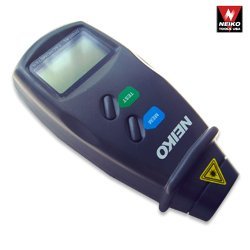 This
little gem was inexpensive and really helpful in checking our engine RPM
versus what our RPM guage was telling us. You put a reflective tab
(supplied) on your rotating item, and then just 'shoot' it with the gun.
It is very accurate. We found a friend's tach that was reading 25%
high! He was just about to get re-propped, because he thought he
wasn't going fast enough for the RPM he was turning.
This
little gem was inexpensive and really helpful in checking our engine RPM
versus what our RPM guage was telling us. You put a reflective tab
(supplied) on your rotating item, and then just 'shoot' it with the gun.
It is very accurate. We found a friend's tach that was reading 25%
high! He was just about to get re-propped, because he thought he
wasn't going fast enough for the RPM he was turning.
We bought ours at Amazon.com (click here).
You can buy a $120 adaptor from the computer manufacturer, or you can buy a really cheap one with a multi-tip arrangement for $15 on eBay. We have found a compromise... custom adaptors from Priority Electronics. These are ordered by computer model number and are well-made. They have a device that boosts the 12v to the 15-19v that today's laptops want for an input voltage.
Precision Electronic Battery Tester
Take the guesswork out of checking your batteries. Battery Tester... Precision Refractometer
MISCO REFRACTOMETER TEL: 216-831-1000 FAX: 216-831-1195
7084VP+ MISCO Glycol & Battery Specific Gravity Tester (°F) - Model # 7084VP+ - $135.00
3401 VIRGINIA ROAD
CLEVELAND, OHIO 44122
Laser Temperature Gun
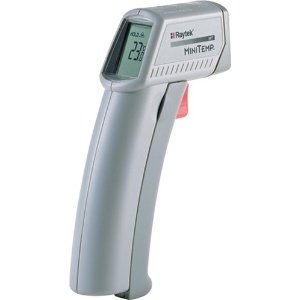 We
use our
Raytek Mini Temp Non-Contact Digital Thermometer Gun all the time
onboard. It is useful in the kitchen (checking the temp of your yeast
water, to make sure you don't kill your yeast while baking), in our
refrigeration toolkit, and in our engine toolkit. With this little
hand-held device, you 'shoot' any surface you want to take the temperature
of, and it immediately indicates the surface temp of whatever you are aiming
at.
We
use our
Raytek Mini Temp Non-Contact Digital Thermometer Gun all the time
onboard. It is useful in the kitchen (checking the temp of your yeast
water, to make sure you don't kill your yeast while baking), in our
refrigeration toolkit, and in our engine toolkit. With this little
hand-held device, you 'shoot' any surface you want to take the temperature
of, and it immediately indicates the surface temp of whatever you are aiming
at.
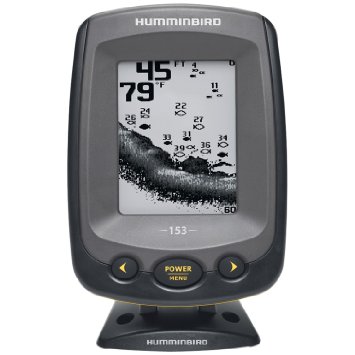 When our 10-year-old
Datamarine depth sounder started acting wonky, we
did a temporary install of a very inexpensive ($89) Humminbird fish finder we had
bought for installation in the dinghy. Setting it up for our dinghy
hadn't made its way to the top of our "to do" list--it was still
sitting in our "projects" box in the originally packaging. So Dave did a
"temporary" install at our helm station to get us through the cruising
season with a working depth sounder. We literally had it taped to
console in the cockpit for about 6 months.
When our 10-year-old
Datamarine depth sounder started acting wonky, we
did a temporary install of a very inexpensive ($89) Humminbird fish finder we had
bought for installation in the dinghy. Setting it up for our dinghy
hadn't made its way to the top of our "to do" list--it was still
sitting in our "projects" box in the originally packaging. So Dave did a
"temporary" install at our helm station to get us through the cruising
season with a working depth sounder. We literally had it taped to
console in the cockpit for about 6 months.
This worked so well that on our new boat (the catamaran), we bought an inexpensive ($500) Garmin "fishfinder" GPSMap 526s with an included fishfinder.
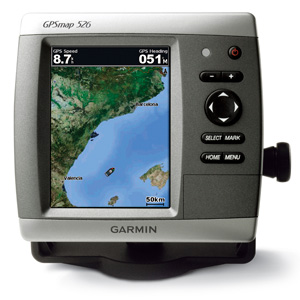
Mounting Fishfinder Transducer Inside the Hull: Here is what Dave emailed to a friend who was trying to do the same thing, about our "temporary" (now permanent) installation on our monohull:
We mounted our transducer inside the hull, in a place where it would go through solid
fiberglass about 1" thick. If your hull is cored, or plywood, it may or may
not work as well as ours does. Ours works to about 300 feet. It also works
well enough through the hull in anchoring depths to be able to see the
bottom profile and get an idea of what's down there (mud, grass, rock,
sand).
We tested it in this location before sticking it down by pressing the bottom of the
transducer right on the inside of the hull where I wanted to mount it, and
see if we got reasonable readings.
The instructions suggested that it would not work with silicone because of
bubbles, and they wanted me to mount it in epoxy. But I didn't want such a
permanent mount--this was only temporary (3 years ago--ha!). So I just used 3M
Marine silicone.
I picked a spot in my engine room (the location where we could reach with
display at the helm and the standard length cord routed through the porthole
to the engine room, in the cockpit). Ours is mounted about 3 feet
off centerline, NOT exactly leveled with the bottom, and NOT
attached to any supporting things. It was installed with a liberal goop of
silicone and pressed flat onto the fiberglass inside the hull, in the engine
room. You just need to make sure your goop of silicone doesn't end up
with any air bubbles in it.
We estimate that the transducer has a 10-12 degree tilt, outward from the
center of the boat. Which, in the grand scheme of things, isn't much in
depth error, considering we had no depth sounder at all to start with. The cheapie Humminbird has an offset correction, so it is reading
conservatively (like 2' less than what's actually there, because it's
location on the hull is about 2' below the waterline), so the 6-12-inch error
in depth reading
caused by the 10 degree tilt isn't much.
Even if you get a little tilt, the error is pretty small. At the time, we
were going from no depth sounder at all, so a foot or two of known error (in
shallow water) was no big deal.
We did this temporary arrangement in 2011, and when we sold or mono in 2015, it was still our primary depth sounder. Even if you already have a satisfactory depth sounder, it is well worth having one of these onboard as a backup, in case your primary quits working. And we really think the fish finder is a much better depthsounder for cruising--you know much more about the bottom you are traveling over. (we turn off the distracting "fish" symbols).
Other friends did the same thing with low-end Garmin fish finder.
Our planned installation in the dinghy will be to put a motorcycle battery and the display in a water-resistant box, and mount the transducer on a bracket on the stern of our inflatable. The trandsducer is removable from the whole bracket, so the whole thing comes out of the dinghy easily when we're not using it. And we recharge the motorcycle battery on board the big boat. A friend had this setup and it worked great for diving and gunkholing
On our cat, the "in hull" transducer that came with the Garmin 526s mounting was even easier. We just tossed the transducer in the small bilge area in the bottom of one hull. Works great!
